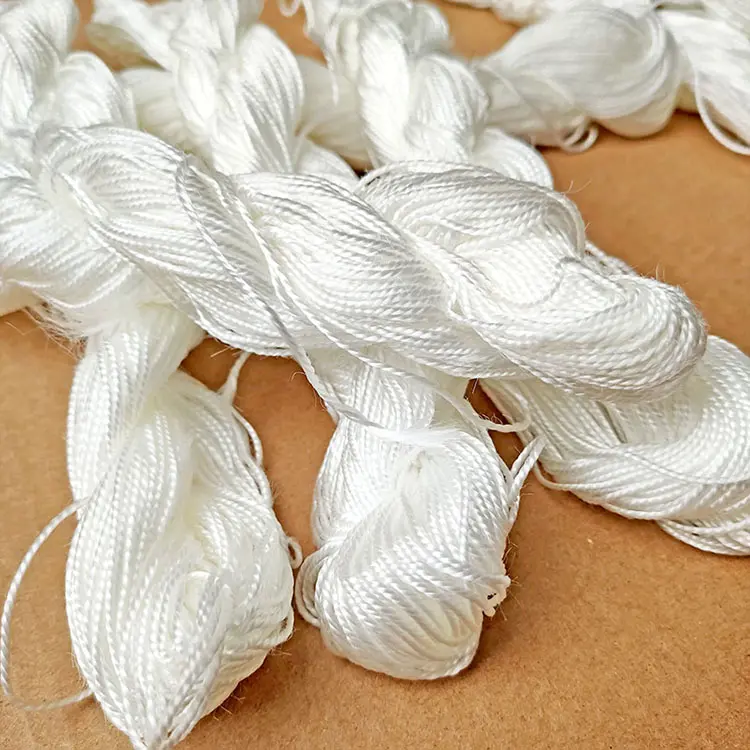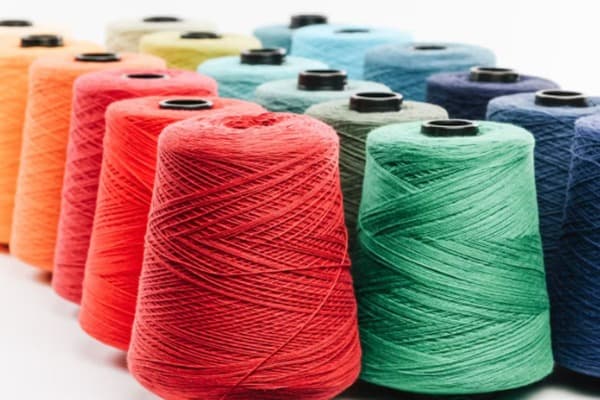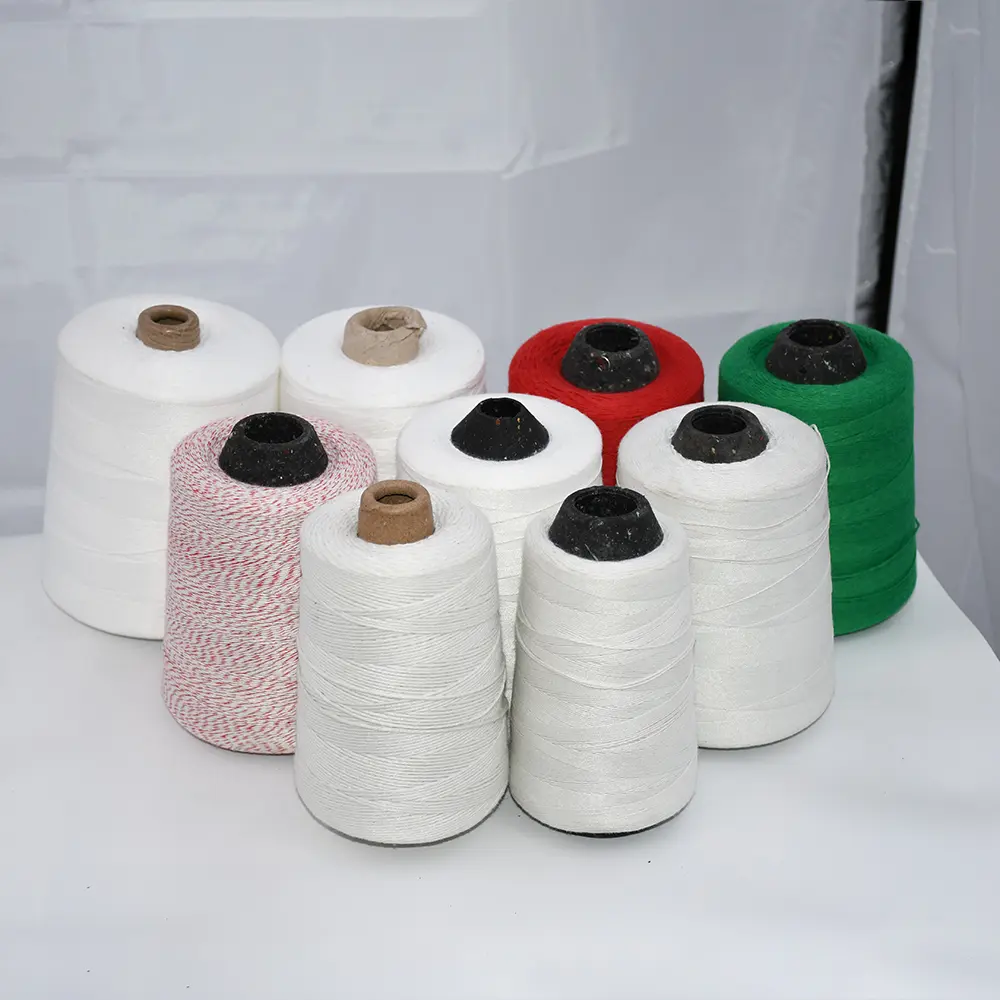Stepping into the world of weaving is an exciting journey, but the vast ocean of yarn choices can feel overwhelming. As a manufacturer and supplier of textile yarns for decades, my name is Allen, and I’ve helped countless designers and large-scale weaving mills—people just like Mark Thompson from the USA—navigate this very challenge. Choosing the right yarn is the single most important decision you’ll make for your weaving project. It determines the strength, texture, drape, and ultimate purpose of your finished cloth. This guide is here to demystify the process, breaking down everything from fiber types and yarn size to the critical differences between warp and weft. By the end, you’ll have the confidence to select the perfect yarn for weaving anything from a delicate scarf to a durable rug.
What’s the Difference Between Yarn for Warp and Weft?
Before you can choose any yarn, you must understand the two fundamental components of any weave: the warp and the weft. The warp threads are the long, vertical yarns that are held under high tension on the loom. They form the backbone of your fabric. The weft threads are the horizontal yarns that you weave over and under the warp to create the cloth. This distinction is crucial because they serve very different roles.
Your warp yarn needs to be strong, smooth, and have very little stretch. Think of it as the skeleton of your project. It will be stretched taut on the loom, threaded through heddles, and beaten into place, so it must withstand significant friction and tension without pilling, fraying, or breaking. Experiencing broken warps is a frustrating part of the weaving process that a strong warp yarn can help you avoid. Smoothness helps the warp threads glide past each other without getting snagged.
The weft yarn, on the other hand, has a much easier job. It isn’t held under tension, so you have far more freedom to play with texture, color, and novelty. This is where you can use fluffy, bumpy, or delicate yarns to create visual interest. The weft’s primary job is to fill in the space and create the fabric’s pattern and character. While your warp provides structure, your weft provides the personality.
Which Natural Fiber is Best for Weaving?
The world of natural fibers offers a rich palette of textures and properties for every weaver. The best natural fiber for you depends entirely on what you want to create. As a yarn manufacturer, we process tons of different fibers, and each has its unique strengths.
- Cotton: This is perhaps the most popular and versatile
weaving yarn. Cotton is strong, has minimal stretch (making it an excellentwarp), is highly absorbent, and takes dye beautifully. It’s the go-tofiberforhome textileslike atowel,hand towels, andplacemats. Finercotton yarnsare used for lightweightapparel, while thicker plies create sturdy cloth. A blend likecottolin(cotton/linen) is also a fantastic choice, offering the softness of cotton with the strength and crispness oflinen. - Linen: Made from the flax plant,
linenis one of the strongest natural fibers available. It’s exceptionally strong, has virtually no stretch, and becomes softer with every wash. This makes it a superioryarn for weavingdurable items. However, its inelasticity can make it challenging for thosenew to weaving. It’s perfect for elegantkitchen towelsand fine table linens. - Wool:
Woolis the weaver’s choice for warmth and elasticity. Unlike cotton andlinen,wool yarnhas a natural crimp and stretch, which creates a fabric that is cozy, insulating, and resilient. It can be used for bothwarp and weft, though a strong, smooth worsted-spunwoolis best for thewarp.Woolis ideal for blankets, scarves, andgarmentfabric. Softer varieties likemerinoare wonderful against the skin, while more ruggedwool fibersare great for outerwear. - Silk & Alpaca: These are luxury fibers known for their incredible softness, beautiful
drape, and natural sheen. They are often used in theweftto add a touch of elegance to ascarfor shawl. While a strong spun silk can be used forwarp, these fibers are generally more delicate and expensive, making them special occasion choices for most weavers.
Are Synthetic Fibers a Good Choice for a Weaving Project?
While natural fibers are often romanticized in the weaving world, synthetic fibers have an important and practical place. For projects that require exceptional durability, vibrant color that won’t fade, or specific performance characteristics, synthetics are an excellent choice. At our facilities, we produce a wide range of synthetic yarns, like polyester and polypropylene, that are engineered for strength and consistency.
Polyester is incredibly strong, resistant to stretching and shrinking, and holds color exceptionally well. This makes it a reliable choice for a warp that won’t sag. A spun polyester yarn can mimic the feel of cotton but with added strength. Acrylic is a popular synthetic fiber because it is lightweight, soft, and hypoallergenic. It’s an affordable alternative to wool and comes in a huge array of bright colors, making it great for decorative items or projects for those with wool allergies.
For items that need to be extremely tough, like outdoor mats or heavy-duty bags, a yarn like polypropylene is unmatched. It’s resistant to moisture, mildew, and abrasion. While you might not weave a cozy scarf from it, its strength and durability are perfect for certain applications. You can even find yarns with a metallic thread or a bit of sparkle for decorative effect, which are almost always made with a synthetic component.

How Does Yarn Size and Weight Affect My Weaving?
Yarn size is one of the most critical factors in planning your weaving project. It directly influences the thickness and density of your final cloth. A finer yarn will create a lighter, more delicate fabric with a beautiful drape, while a thick yarn will produce a heavy, sturdy fabric much more quickly.
In weaving, yarn size is often discussed in terms of sett, or Ends Per Inch (EPI). This refers to how many warp threads are packed into one inch of width on your loom.
- A thick,
worsted weightyarnmight have a sett of 8-10 EPI. - A
fineryarn, like a standard weaving cotton, might have a sett of 20-24 EPI.
The yarn weight system used in knitting (e.g., DK, worsted) can be a helpful starting point, but weaving has its own more precise numbering systems (like the cotton count system). The key takeaway is that the thicker your yarn, the lower your EPI will be, and the faster your project will weave up. The yarn size you choose for your warp is what will determine sett, which in turn dictates how the entire fabric will look and feel.
Can I Use Knitting Yarn for Weaving on a Loom?
This is a common question from weavers who also knit or crochet. The answer is: yes, but with caution. You can absolutely use knitting yarn for weaving, especially in the weft. The weft is the perfect place to use up your stash of beautiful hand dyed merino or textured acrylic yarn.
Using knitting yarn for the warp is trickier. Most knitting yarn is designed to be lofty, soft, and stretchy—all qualities that are the opposite of what you want in a good warp. A stretchy warp will sag on the loom under tension, making it impossible to get an even beat and a consistent fabric. Furthermore, many single-ply knitting yarns are too delicate and will shred or break from the friction.
If you want to use a knitting yarn for warp, look for a multi-ply yarn that is smooth and tightly spun, often called a "worsted spun" yarn (not to be confused with worsted weight). A good test is the "snap test." Take a short length of yarn and pull it sharply. If it breaks easily, it is not suitable for warp. If it holds strong, it might work. When in doubt, stick to designated weaving yarn for your warp threads and save the fun knitting yarns for the weft.
How Do I Choose the Right Yarn for a Scarf?
When you weave a scarf, you’re creating something that will be worn next to the skin, so softness is the top priority. You also want a fabric with a lovely drape that flows and doesn’t feel stiff. This means you should look for a finer yarn.
For the warp, a fine merino wool or a silk blend is a luxurious choice. They are strong enough for the loom but produce an incredibly soft fabric. A more budget-friendly but still excellent option is a high-quality cotton yarn, which will result in a lighter-weight, breathable scarf. For the weft, you can match your warp fiber or introduce something with a different texture, like a soft alpaca or a fluffy mohair, to add warmth and a beautiful halo effect. An airy, open weave with a finer yarn will feel much nicer than a dense fabric made from a thick yarn.
What is the Best Weaving Yarn for Kitchen Towels and Placemats?
For items used in the kitchen, you need a yarn that is absorbent, durable, and machine washable. This makes cotton the undisputed king. A strong, smooth, un-mercerized cotton yarn is the perfect yarn for weaving towels because it is incredibly absorbent. Brands like Brassard are famous for their cotton weaving yarns for a reason.
Cottolin, a blend of 60% cotton and 40% linen, is another top-tier choice. It gives you the best of both worlds: the softness and absorbency of cotton combined with the strength, crispness, and durability of linen. After a few washes, cottolin towels become wonderfully soft and absorbent.
For placemats, you want something that is a bit stiffer and can be wiped clean easily. Here, mercerized cotton is a great option. The mercerization process makes the cotton yarns stronger, smoother, and gives them a slight sheen, which also makes them less absorbent and more stain-resistant—perfect for a placemat, but not for a towel.

What Kind of Yarn Should I Use to Weave a Rug?
Weaving a rug requires a completely different mindset. Here, durability is everything. A rug needs a yarn that can withstand heavy foot traffic, abrasion, and tension.
The ultimate yarn for weaving a rug is wool. Wool is naturally resilient, dirt-repellent, and flame-retardant. Its natural elasticity allows it to bounce back after being crushed underfoot, so your rug will look good for years. A thick, tightly spun wool yarn, often sold as "rug wool," is ideal for both the warp and the weft. A strong cotton or linen rug warp is also commonly used, with wool as the weft.
For a more affordable or outdoor rug, heavy-duty synthetic fibers are a practical choice. A thick ply of acrylic or polypropylene can create a durable and colorful rug that is easy to clean. You want a thick, heavy weight yarn that will pack down tightly to create a dense, hard-wearing fabric. This is not the place for delicate, one strand of yarn wonders.
How Do I Calculate How Much Yarn I Need for My Next Weaving Project?
Calculating your yarn needs can feel like complex math, but it’s essential for ensuring you don’t run out of yarn mid-project. Most weaving software will do this for you, but here’s a basic formula to get you started:
-
Warp Calculation:
(Number of Warp Ends) x (Total Warp Length in yards) = Total Warp Yardage Needed- Number of Warp Ends = (Width of project in inches) x (Ends Per Inch/Sett)
- Total Warp Length = (Length of project) + (Loom Waste + Take-up). Loom waste is typically about 2/3 of a yard.
-
Weft Calculation:
- This is a bit trickier, but a good rule of thumb is that you will need slightly less
weftyarnthanwarpyarnfor a balancedweave. A safe estimate is to plan for the same amount ofweftaswarp. (Width of project in inches) x (Picks Per Inch) x (Length of project in inches) / 36 = Total Weft Yardage Needed
- This is a bit trickier, but a good rule of thumb is that you will need slightly less
Always buy more yarn than you calculate. It’s heartbreaking to run out of a specific cream yarn or hand dyed lot just a few inches from the end of your weave. For clients like Mark, who are ordering in bulk, we build in a 5-10% overage to account for any potential issues during production.

Why is Making a Sample So Important in Weaving?
If there is one piece of advice I could give to every weaver, it’s this: always weave a sample. No matter how much you plan, you never truly know how a yarn will behave until you weave with it. A sample allows you to test your yarn choices, confirm your sett (EPI), and see how the fabric feels after it’s been washed and finished.
When you wash your sample, the yarn will "bloom" and settle into its final state. A fabric that looks loose and holey on the loom can transform into a perfect cloth after washing. Sampling allows you to make adjustments before you commit hours of your time and yards of your precious yarn to the full project. It’s the single best way to ensure that the fabric in your head becomes the fabric in your hands. It’s a professional practice that every hobbyist weaver should adopt.
Key Takeaways
Choosing the right yarn is the foundation of a successful weaving project. By understanding the properties of different fibers and how yarn size works, you can confidently plan and execute your vision.
- Warp vs. Weft: Your
warpyarnmust be strong, smooth, and low-stretch. Yourweftyarncan be more decorative and textural. - Fiber Matters: Choose your
fiberbased on the project’s end use. Cotton for absorbency,linenfor strength,woolfor warmth, and synthetics for durability. - Size Dictates Fabric: The thickness of your
yarndetermines the sett (EPI) and the final density anddrapeof your cloth. - Knitting Yarn is for Weft: Use stretchy, delicate knitting yarns primarily for the
weft, not the high-tensionwarp. - Match Yarn to Project: Use soft, fine yarns for scarves; absorbent, durable cotton yarns for towels; and heavy-duty
woolor synthetic yarns for rugs. - Always Sample: Weaving a small sample is the best way to test your
yarnand sett choices to guarantee a successful outcome.





